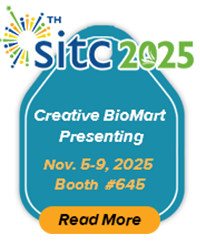BTC
-
Official Full Name
betacellulin -
Overview
The protein encoded by this gene is a member of the EGF family of growth factors. It is synthesized primarily as a transmembrane precursor, which is then processed to mature molecule by proteolytic events. This protein is a ligand for the EGF receptor. -
Synonyms
BTC;betacellulin;probetacellulin;Betacellulin;Betacellulin precursor;BTC;BTC_HUMAN;OTTHUMP00000160600;OTTHUMP00000219057;Probetacellulin;OTTHUMP00000160600;OTTHUMP00000219057
Recombinant Proteins
- Human
- Mouse
- Bovine
- Rhesus macaque
- Chicken
- Zebrafish
- Cynomolgus
- Rat
- E.coli
- HEK293
- Mammalian Cells
- Human Cells
- Insect Cells
- In Vitro Cell Free System
- Yeast
- GST
- Fc
- His
- Non
- rFc
Background
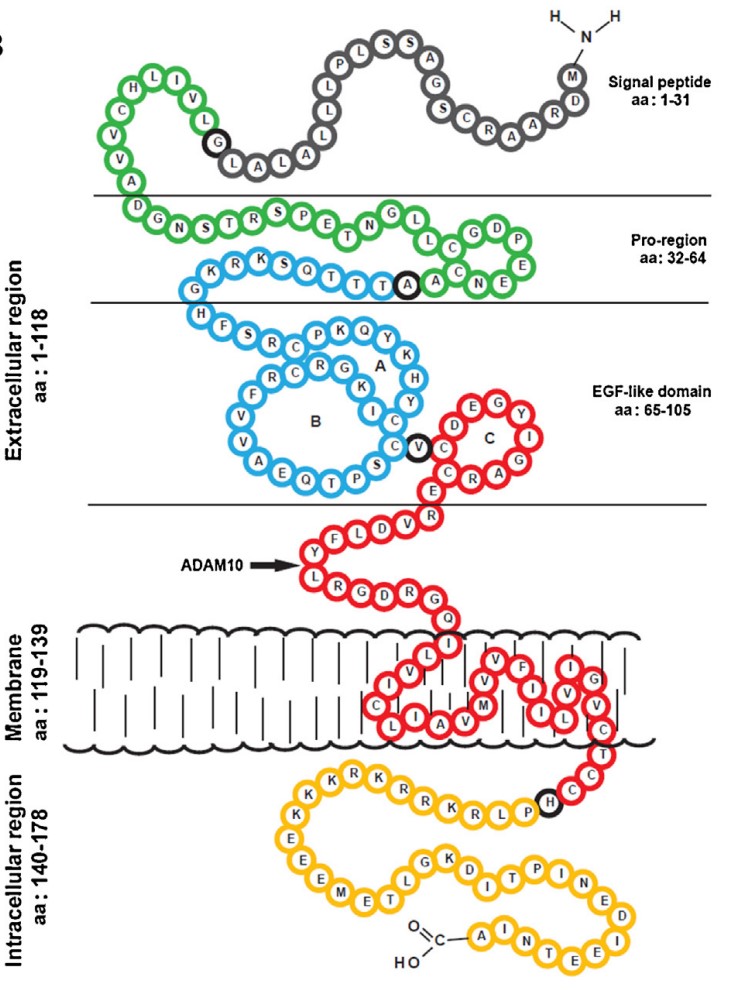
Fig1. Structure of the full length BTC precursor protein, showing its major domains, the three disulfide-bonded intramolecular loops (A–C) formed by the six conserved cysteine residues, and the site of proteolytic processing by ADAM10. (Maik Dahlhoff, 2014)
What is BTC protein?
BTC (betacellulin) gene is a protein coding gene which situated on the long arm of chromosome 4 at locus 4q13. Betacellulin (BTC) is a member of the EGF family of cytokines that also includes EGF, TGF-a, Amphiregulin, HB-EGF, Epiregulin, Tomoregulin and the Neuregulins. It is expressed in most tissues including kidney, uterus, liver and pancreas. BTC also presents in body fluids, including serum, milk, and colostrum. At the amino acid sequence level, human mature BTC protein exhibits 80 % identity with mouse BTC protein. The protein binds to EGFR, ERBB4 and other EGF receptor family members and acts as a potent mitogen for retinal pigment epithelial cells and vascular smooth muscle cells. The BTC protein is consisted of 178 amino acids and its molecular mass is approximately 19.7 kDa.
What is the function of BTC protein?
The main functions of BTC in vivo include promoting cell proliferation, cell differentiation and cell migration, especially the expression and function of insulin secreting cells, nerve cells, heart muscle cells and tumor cells have been extensively studied. It can stimulate the proliferation of a variety of cell types and promote tissue cell growth and regeneration. It can promote insulin synthesis and secretion in insulin secreting cells, and may have a protective effect on the growth and secretion function of islet cells. It also regulates cell migration and differentiation.
BTC Related Signaling Pathway
BTC regulates cell growth and survival by binding to the epidermal growth factor receptor (EGFR) and HER4 receptors, activating these receptors and promoting activation of downstream signaling pathways. Betacellulin can promote cell survival and proliferation by activating the PI3K/AKT signaling pathway. Binding of BTC can activate Ras protein, which in turn activates the MAPK cascade, affecting cell growth, differentiation and stress response. In addition, BTC can also participate in Wnt, Notch, Hedgehog and other signaling pathways, and play a role in cell development and growth.
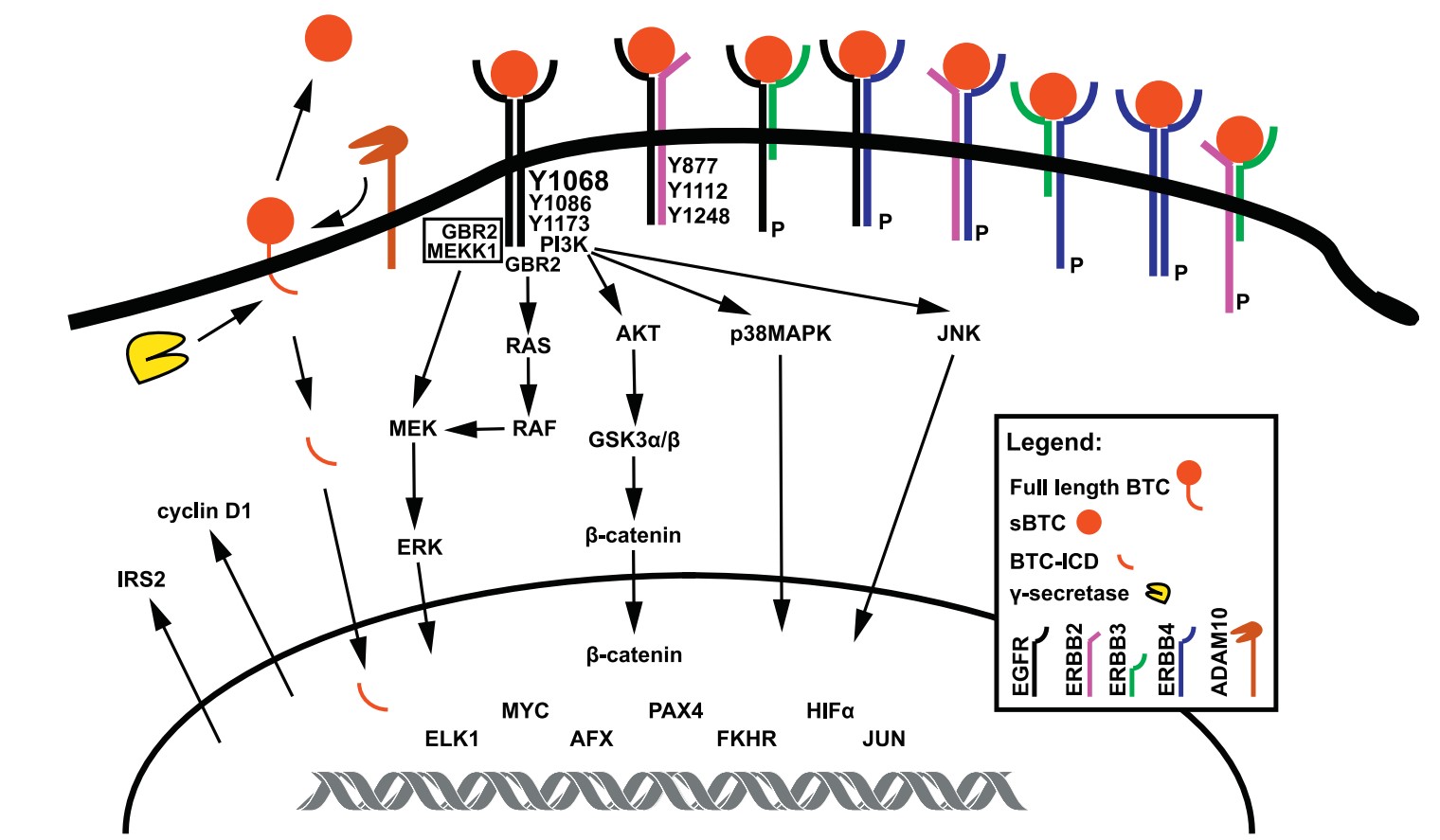
Fig2. BTC receptor binding and intracellular signaling. After proteolytic release by ADAM10, soluble BTC can bind and activate numerous EGFR/ERBB receptor combinations and activate a wide range of intracellular signaling pathways. (Maik Dahlhoff, 2014)
BTC Related Diseases
BTC protein can promote proliferation, invasion and metastasis in breast cancer, pancreatic cancer, colorectal cancer, ovarian cancer, colorectal cancer and other malignant tumors, and is closely related to the clinical characteristics of tumor deterioration and prognosis. In addition, BTC is also associated with several inflammatory and metabolic diseases, such as diabetes, and skin diseases.
Bioapplications of BTC
BTC has shown excellent potential in the experimental research phase, including the role of wound healing, bone growth and repair. At the same time, it has also been studied as a diagnosis and treatment means for tumor treatment and neurological disease regeneration and rehabilitation. However, its clinical application is still in its infancy, and more research and clinical trials are needed to confirm its application potential in various fields.
Case Study
Case study 1: Yuxi Li, 2023
The gap junction protein, connexin 43 (Cx43) is highly expressed in human granulosa-lutein (hGL) cells. The phosphorylation of certain amino acid residues in the Cx43 protein has been shown to be related to a decline in gap junction intercellular communication (GJIC), which subsequently affects oocyte meiotic resumption. As a member of the epidermal growth factor (EGF) family, betacellulin (BTC) mediates luteinizing hormone (LH)-induced oocyte maturation and cumulus cell expansion in mammalian follicles. Whether BTC can regulate Cx43 phosphorylation, which further reduces Cx43-coupled GJIC activity in hGL cells remains to be determined.
The expression levels of Cx43 and phosphorylated Cx43 were examined following cell incubation with BTC at different time points. Real-time-quantitative PCR and western blot analysis were used to detect the specific mRNA and protein levels, respectively. GJIC between SVOG cells were evaluated using a scrape loading and dye transfer assay. The results showed that BTC induced the rapid phosphorylation of Cx43 at serine368 without altering the expression of Cx43 in primary and immortalized hGL cells. BTC promptly induced the phosphorylation of connexin 43 at Ser368, leading to decreased GJIC activity in hGL cells. The BTC-induced cellular activities were most likely driven by the EGFR-mediated PKC-dependent signaling pathway.
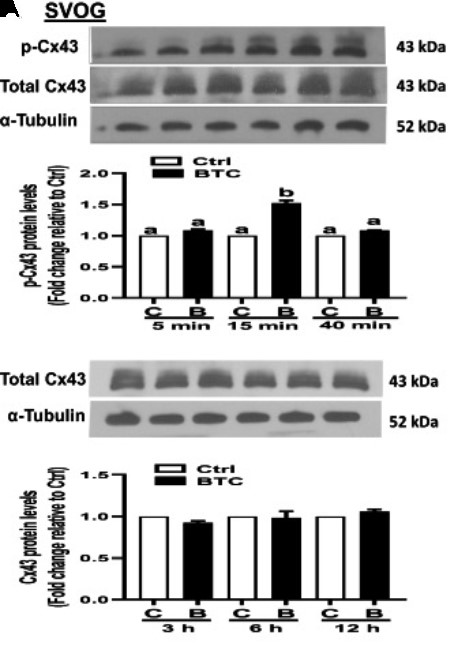
Fig1. SVOG cells were treated with 50 ng/ml BTC for different time durations (5, 15, or 40 min), and the levels of phosphorylated Cx43 protein were examined via Western blot analysis.
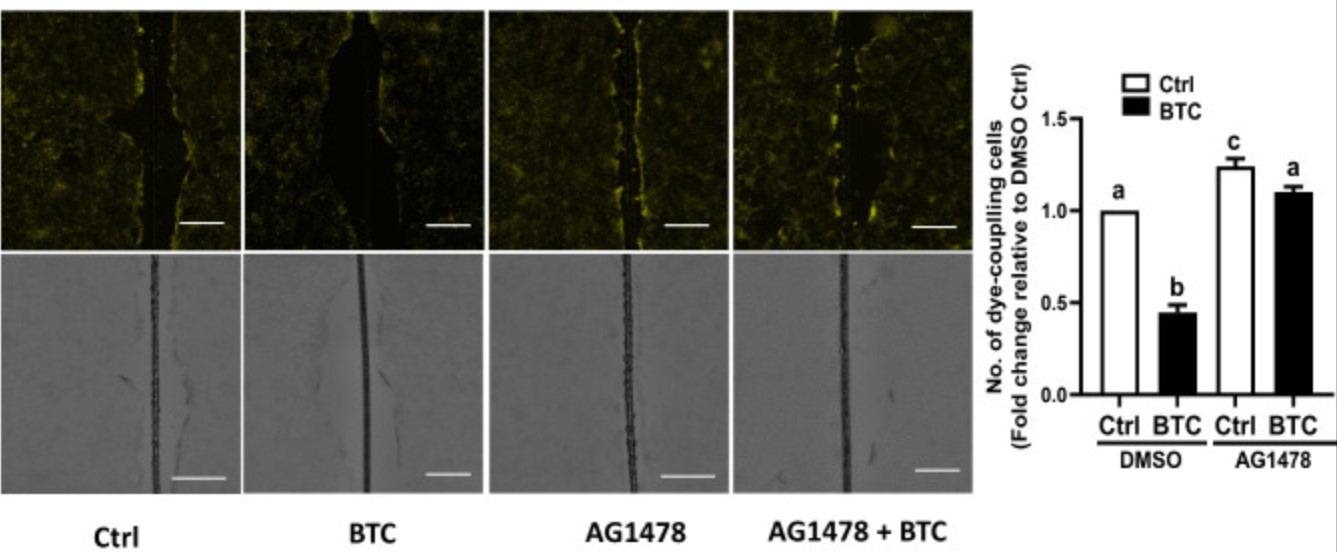
Case study 2: Jianfang Zhao, 2016
Epithelial ovarian cancer is the leading cause of death among gynaecological cancers. Previous studies have demonstrated that epidermal growth factor receptor (EGFR) ligands can induce ovarian cancer cell invasion by down-regulating E-cadherin. Betacellulin is overexpressed in a variety of cancers and is associated with reduced survival. However, the biological functions and clinical significance of betacellulin in ovarian cancer remain unknown.
Treatment of SKOV3 and OVCAR5 ovarian cancer cell lines with betacellulin down-regulated E-cadherin, but not N-cadherin. In addition, betacellulin treatment increased the expression of Snail and Slug, and these effects were completely blocked by pre-treatment with EGFR inhibitor AG1478. Betacellulin treatment induced the activation of both the MEK-ERK and PI3K-Akt signaling pathways, and it also significantly increased ovarian cancer cell migration. Importantly, the effects of betacellulin on E-cadherin, Slug and cell migration were attenuated by pre-treatment with either U0126 or LY294002.

Fig3. Cells were treated for 24 hours without (Ctrl) or with increasing concentrations of betacellulin (BTC: SKOV3, 0.5, 1, 5 or 10 ng/ml; OVCAR5, 1, 10, 20, 50 or 100 ng/ml), E-cadherin and N-cadherin protein levels were examined by Western blot.
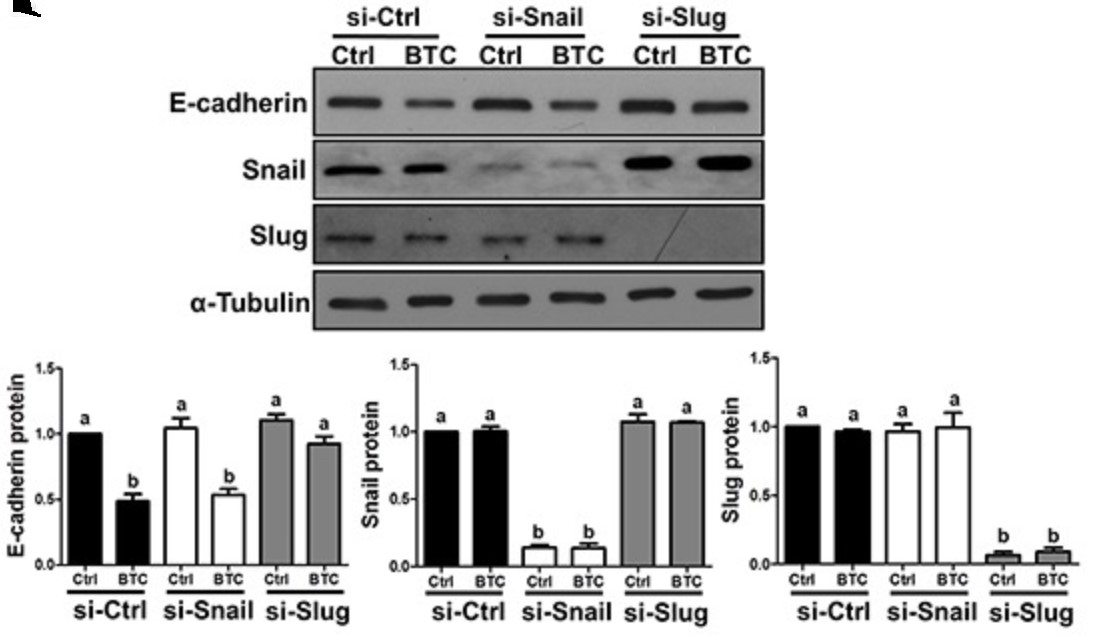
Quality Guarantee
High Purity
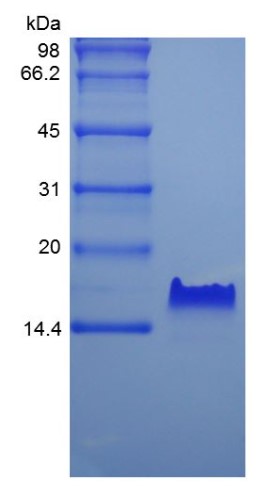
Fig1. SDS-PAGE (BTC-21H) (PROTOCOL for western blot)
.
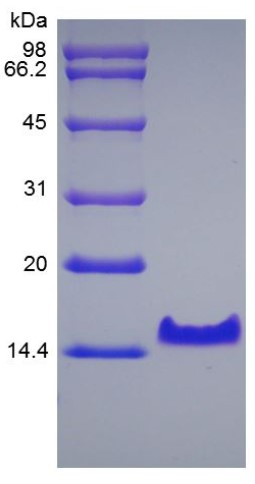
Fig2. SDS-PAGE (Btc-566M) (PROTOCOL for western blot)
Involved Pathway
BTC involved in several pathways and played different roles in them. We selected most pathways BTC participated on our site, such as ErbB signaling pathway, which may be useful for your reference. Also, other proteins which involved in the same pathway with BTC were listed below. Creative BioMart supplied nearly all the proteins listed, you can search them on our site.
| Pathway Name | Pathway Related Protein |
|---|---|
| ErbB signaling pathway | HRAS,SHC2,NCK2,MAP2K7,PAK3,CAMK2A,AREG,PAK4,CDKN1BB,AKT2L |
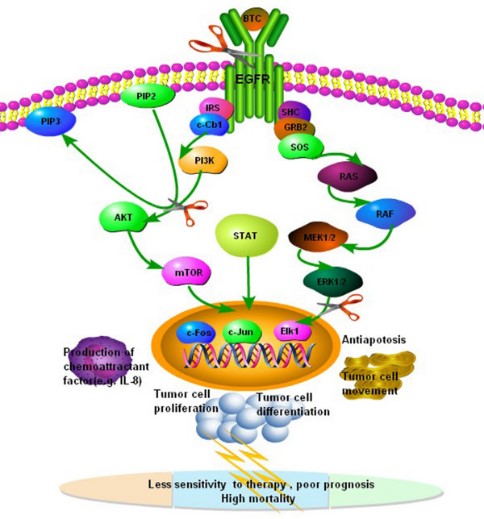
Fig1. Proposed mechanism of BTC-stimulated IL-8 production and bio-behaviors of lung cancer cells. (Lin Shi, 2014)
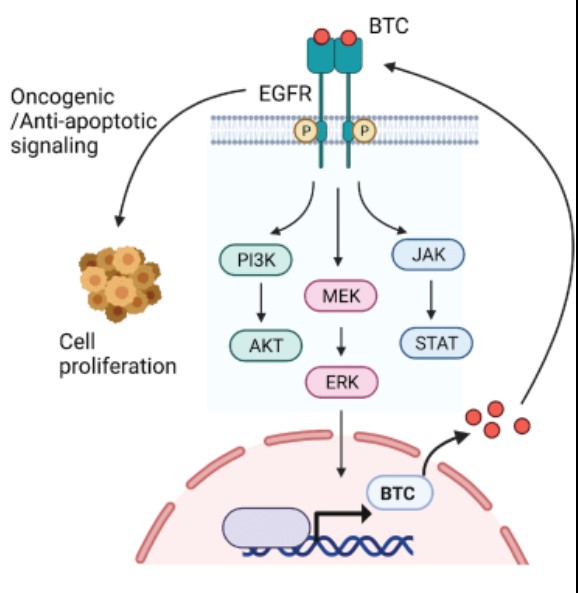
Fig2. Model showing the mechanism of BTC action in EGFR mutant lung adenocarcinoma. (Suresh Chava, 2022)
Protein Function
BTC has several biochemical functions, for example, epidermal growth factor receptor binding,growth factor activity,protein binding. Some of the functions are cooperated with other proteins, some of the functions could acted by BTC itself. We selected most functions BTC had, and list some proteins which have the same functions with BTC. You can find most of the proteins on our site.
| Function | Related Protein |
|---|---|
| epidermal growth factor receptor binding | AREG,Fert2,GRB2,VAV2,FAM83B,HBEGFB,SNX1,AGR2,ARF4,SOCS5 |
| protein binding | TMUB2,PIPOX,KHDC1B,SUV39H2,NFATC3,FBXL15,ATP6V1E1,ASCL4,GDF7,NCBP1 |
| growth factor activity | NTF7,FGF10B,EGF,FGF13,JAG2,PROK1,CDNF,BMP6,MIA,IL10 |
Interacting Protein
BTC has direct interactions with proteins and molecules. Those interactions were detected by several methods such as yeast two hybrid, co-IP, pull-down and so on. We selected proteins and molecules interacted with BTC here. Most of them are supplied by our site. Hope this information will be useful for your research of BTC.
S100A4;KRT31;GMPPA;ERBB2
Resources
Research Area
Related Services
Related Products
References
- Gezginci-Oktayoglu, S; Karatug, A; et al. Nerve Growth Factor Neutralization Suppresses beta-Cell Proliferation Through Activin A and Betacellulin. PANCREAS 44:243-249(2015).
- Celebi, B; Kilic, S; et al. Development of a Novel Francisella tularensis Antigen Stained with Tetrazolium-blue for Tularemia Microagglutination Test. MIKROBIYOLOJI BULTENI 47:514-522(2013).
